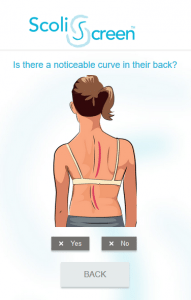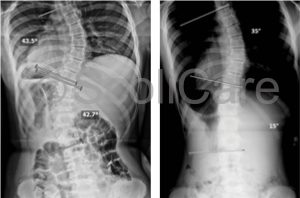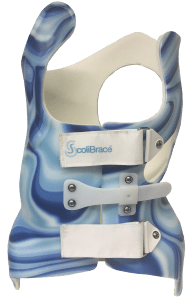Note: This is an updated version of an article which we originally posted here.
Scoliosis is a complex 3 dimensional condition that results in bending of the spine to one side, a rotation to the front or back and a straightening of the spine in the side view. The most common scoliosis in adolescence is thought to be idiopathic which means its exact cause is multi-factorial or unknown.
As we do not know the exact cause nor the exact mechanism through which scoliosis develops, there are many misconceptions about scoliosis. Today, we’ll look at some of the more common misconceptions.
Myth 1 – Scoliosis causes pain
While Scoliosis may be associated with pain as it develops, typically, scoliosis in the early phases does not cause pain. This is why scoliosis screening is so important, and why we provide the scoliscreen app. In Children especially, the early onset of scoliosis might go completely unnoticed.
Myth 2 – “Watchful waiting” is the best approach
In the UK and many other parts of the world a “wait and see” approach is often favored when it comes to scoliosis. The condition is monitored to see if it gets worse, with a view to undertaking a surgical fusion of the spine if the situation becomes bad enough.
In the past, this might have been the best approach, but today we have the know how and technical ability required to create a scoliosis specific exercise program and a customised bracing solution, which can serve to correct the problem before it progresses to the point where surgery would be required. It is easier to improve a more flexible and smaller curve with bracing and scoliosis specific exercise than it is to change a large more rigid curve – so early diagnosis and appropriate treatment makes a big difference.
Myth 3 – Scoliosis screening doesn’t help scoliosis sufferers
Current UK policy does not support mass screenings due to the cost, potential of false positives, belief that bracing doesn’t work and that if the curve is severe enough family or other adults will notice it.
As we mentioned above, since scoliosis does not always cause pain (and most people don’t know how to recognise scoliosis anyway) it’s entirely possible that the condition can go unnoticed in many cases. The earlier the detection, the more appropriately the right treatment can be given at the right time.
We have a scoliscreen app right here on our site, which can guide you through an initial screening process. Give it a go!
Myth 4 – Scoliosis doesn’t progress into adulthood
Historically, scoliosis was most strongly associated with growth – from this it was assumed that when an adolescent stops growing, scoliosis would not progress. It is now known that it often will progress into adulthood – in addition, the bigger the existing curve the more likely it is to progress.
The major reason for progression is the weakening of the ligaments in the spine as we age. As the ligaments weaken, the spine loses stability and the spinal deformity worsens. This means that appropriate exercises and chiropractic care are highly beneficial for us all as we age – but can make a huge difference to a scoliosis sufferer.
The weakening of ligaments causes 30% of the population over the age of 60 years to have scoliosis versus only 3% of adolescents!
Myth 5 – Swimming will help reduce scoliosis
Over many years children have been told to swim to treat scoliosis. While swimming is a great form of exercise in general, there is no evidence to support this idea – although there actually has been some research which suggests that scoliosis can be worsened after swimming. This research is not strong enough to suggest that scoliosis patients should avoid swimming, but we can now say that swimming alone is not an effective treatment.
Myth 6 – Bad posture causes scoliosis
You might think that telling your child to sit upright will stop scoliosis – this makes sense, since often adolescents will have slumping posture, however the slumping posture itself is not necessarily linked to the development of scoliosis.
In fact, for children with scoliosis, the spine will often be straighter than is observed in the average population. Typically, the thoracic kyphosis in adolescent idiopathic scoliosis will be reduced and sometimes even bend in the opposite direction!
Often children’s shoulder blades will lift off the thorax (aka winging of the scapula) due to weakness of the serratus anterior muscle which will give the appearance of hunching.
Myth 7 – You can correct scoliosis by just sitting up straight
Scoliosis is more than just twisting of the spine, it’s cause is often mutli-factorial thus a multi-factorial treatment must be given. Sitting up straight might help a little, since postural exercises might well be an effective element of a treatment program, but the right treatment will be different for every patient – that’s why we take time to go through a detailed consultation process with each patient.
Myth 8 – Spinal braces don’t work in correcting scoliosis

After 8 months with scolibrace, The lumbar curve in this patient was corrected by a staggering 28 degrees!
Spinal bracing has been the subject of intense research over the past 15-20 years. Far from the myth that they are ineffective, spinal braces have been shown to reduce progression in 70 to 80% of cases compared to those who aren’t braced.
Among some healthcare professionals, the notion that scoliosis braces don’t work does still exist however this is most usually because there is confusion about the kind of bracing being discussed. Bracing technology itself has come a long way in the last few years. Traditional medical braces are designed to hold the spine in the patient’s scoliotic position, which might halt progression, but it actually does nothing to improve the curve.
In contrast, our Scolibrace braces are an active over-corrective brace which works to shift the spine in the opposite, direction back towards normal posture. In addition, they help to shift the mechanical loading of the spine to stimulate normal spinal growth. This not only helps to reduce the likelihood of progression but also improves the potential correction.
Traditional braces, therefore don’t work in correcting scoliosis (although they might stop it getting worse) Scolibrace braces, however, actively work to correct the position of the spine, and have been shown to be highly effective in doing so.
Myth 9 – Scoliosis only affects girls
Scoliosis is more common in girls than boys, but boys can and do develop scoliosis.
Scoliosis is particularly common in ballet dancers and gymnasts, which might be at the heart of this misconception, but there is no doubt the boys and girls can both develop scoliosis.
Myth 10 – Spinal manipulation can reduce scoliosis
Spinal adjustment and manipulation can often help to improve spinal mobility and ease areas of aches and pains in those who have scoliosis, just as it can for those who don’t – but spinal manipulation alone will not reduce scoliosis.
While chiropractic adjustments can form a valuable part of an overall treatment regime, there is no evidence from the scientific literature to support the assertion that spinal manipulation and adjusting techniques alone can reduce scoliosis. Where adjustments may be highly beneficial is in support of an exercise and lifestyle regime, as a method of increasing range of motion, and reducing pain in some cases.
Myth 11 – Physiotherapy exercise reduces scoliosis
Just like chiropractic care, physiotherapy can help to improve mobility and function for scoliosis patients and might form part of an overall program – however again there is no evidence to show that generalised exercise, massage, mobilisation or core stability will improve a scoliotic curve. Bracing and scoliosis specific exercise are currently the only non-surgical methodologies which is clinically indicated as effective in treating scoliosis.
Myth 12 – Heavy backpacks cause scoliosis
Heavy backpacks cause uneven loading and are never good for children’s spines and posture… but they don’t cause scoliosis. If it was the case every child would have scoliosis!
Myth 13 – Scoliosis worsens in pregnancy or will stop me having children
Current research knowledge shows that women are not at a increased risk of progression in pregnancy, however carrying a baby will produce more stress upon the body and the spine which will increase the likelihood of pain and discomfort as for all women in pregnancy.
At birth it is important for the anaesthetist to be aware that a mother has scoliosis, as it will affect the position of the spine if they need to give a epidural injection. It will not, however affect the woman’s ability to carry a child or give birth.

Just one of our many scolibrace color options!
Myth 14 – Surgery is the only treatment for scoliosis
Surgery is sometimes the only option for large curves at high risk of progression. 50 degrees is the typical indicator for surgery as the curve is at a high risk of progression into adulthood.
Scolibrace with scoliosis specific corrective exercise has been shown to be clinically effective in reducing curves between 20 and 60 degrees, whereas curves between 10 and 20 degrees with a low risk of progression can sometimes be treated by scoliosis specific exercise alone.
As previously mentioned early diagnosis is key, as the chances for arresting and correcting a relatively small angle are very good. If you think that you or someone you may know might be at risk of scoliosis, try our scoliscreen app!


